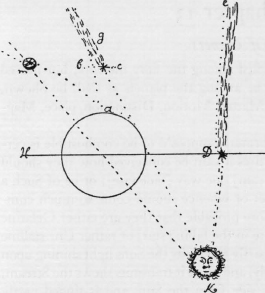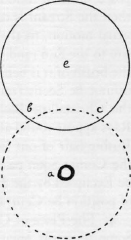Chapter 13
Of Comets
COMETS are Usually handled among the fiery meteors; but indeed their proper place should be among the planets as shall be Shewn, of these may be considered, the Matter, Motion, Distinction, place, Magnitude, and End.1
1. The Matter of Comets formerly suppos’d to be combustible is certainly not So; for If they ware fires it cant be conceived how they should last so long, or send forth a [Stream] one way [Sidewise]; or be of Such a dim Colour as Usually they are; or whence should come so much combustible matter? tis therefore more probable that they are either Gelatine mater (such as is spoken of before in the falling star) or rather Christalline [42] which partly reflects, and partly transmits the Suns light shining upon it; what it reflects Shews the body, and what it transmits shews the Stream, which is alwayes the Contrary side from the Sun, and is tinged partly according to the matter, but Cheifly according to the nearness, or distance of that [Line] which passes between the Sun and our Eye; Just as a Glass of Claret Wine Standing where the Sun, or a Candle shines upon it, If we stand So as we see not the Sun or Candle, we see then the body of the wine by the reflected light and by [the] transmitted on the side farthest from the Luminous body, a Stream coloured as [the] liquor is. This was manifest in that which was thought 2. or 3. Anno 1664; for at first it appear’d with its tail Eastward because the Sun stood west from it, thence it moved north East about [5] Degrees every Day by which means in some dayes it came to be opposite to the Sun, and then it appeared about midnight, as broad as the Moon having the streams not any one way but round about; After this twas Clouddy till the Comets pased into daylight, and So could not be Seen. About 2, or 3 months after it appeard again, a little before Sun rising, and then the Stream was westward, (the Contrary way to what twas before) and much longer; because its being near the Horizon set it [Sidewise] to our Eye; whereas when it appeared near the Mid heaven, the train was foreshortened Standing farther off than the body. As in the Diagram; Suppose (a.) the Eye at the Surface of the Earth whose Horizon is the line (H.D.) at (c.D.m.) is the Star in several postures to the Sun (K.) that at (D.) under or near the Horizon sends its train upright, the Suns light (as to our Eye) being Just under it, and the whole length of the train appears the length of the prik’t line (e.D.) but in the Posture at (c.) The Train stands oblique, the Sun ([as] to our Eye) So standing to it Here though the train be really as long as it was at (D.); yet to our Eye it appears not so Long; but as the line (b.c.) because of the foreshortening; So that though the train[s] (e.D.) and (g.c.) are Equal, yet the lines of their appearrance ([b.c.]) and ([e.D.]) are not So. Yea the Comet at (m) has its train not Seen at all as to length only Some of the breadth of it round about the Star. Now when the Comet was at (D.) near the Horizon, (where the Atmosphere used to be Guilded by the Sun-beams) It from thence appear[ed] more red (like Mars) whereas when it stood before more in the dark, as at (c.) it was of a Dusky blew, (like that of Saturn.) From thence it appears that the matter is transparent, whether it be Gelatine, or Christalline is the next inquiry; If Gelatine, and drawn to one place from elsewhere (as the Star Shot is) then the Supposal must be that the Jelly is Coagulated out of the Steams raised above the attraction of the Earth, (If from the Earth) and there hanging in a kind of Quiescence til some Aids come to cause that Coagulation, but then here are [divers] difficultyes to be Solved; as

1. Concerning their Periodical motion how shall it have beginning? Shall it be by pressure [between] two thick Clouds (as a Cherry Stone [Spirted] from between ones two fingers, or water from ones mouth) if So where should these thick Clouds be? Not in the Upper region for there are no Clouds much less such thick ones [as required.]
2. Whence should all these steams arise? The Earth cant aford matter for Comets of such a Magnitude, as Some, (if not all of them) are.
3. Nor would [Earthy] matter rise to such a [Height], or wander so far from home as beyond the moon where some comets have been.
4. Nay All the planets if they did club for Such a mass would hardly Suffice without Sensible diminution. Therfore the most likly oppinion is that they are not meteors at all; but rather a kind of Christalline planets, Concreated with the Universe which have the Circle of their revolution excentrical from the rest; So that they Somtimes approach nearer to the Earth, and then they come into our veiw, and [so] continue [on] in the revolution untill by distance they pass out of Sight again.
Thus Suppose the little Circle (a.) [be the Earth,] the prick’t circle about it is the dis-[43]tance in which a comet may be seen; If now the Revolution of the Comet be the Upper Circle about the Center (e) tis manifest it can be seen but while it passes between (b. and c.) Hence
N.B. That the same comet will return again in veiw after a certain period of time to ascertain which some Ingeneous persons have so dilligently observed the course of the last comets, that they have given their conjecture at the periods of revolution as is noted in the Phylosophycall transactions.2

2. The motion of the Comets is either diurnal, or Periodical.
1. Diurnal is Such as the Planets have appearing only by the revolution of the Earth about its own Axis (according to Copernicus) for to be Snatched about by the Primum mobile of the Antients crosses their own principles; for that tis not fixed in a Solid orb, and hath [no] intelligence to guide it being but a Sorry meteor, and this indeed adds no Small strength to the oppinion of the Earths revolution, as also [to]
2. The Periodical motion of the Comet, (or Christalline Globe) It must be according to its own proper circle of revolution. Therefore the Comet before mentioned Anno, 1664. must have the plain of its circle lying between N.E. and S.W. for so the motion of the Comet was from S.W. to N.E. (as is aforesaid) This is a hansom Solution of the p[h]ainominon, and possibly in hereafter appearing Comets men may compleat that work already begun (as is before noted) [in] taking a Skilfull and exact notice of a comets motion and Difference of its distances; whereby a Segment of its Circle of revolution might be known, and thence also might be infer’d not only how long at present it would appear, but after how many years it would appear again.
3. The distinction of Comets into Crinite, Barbate, and Caudate Signifies not Several Kinds; [for] one and the Same may be all these (as you may see in the aforesaid Instance [of] 1664.) but the Different appearances of a comet are according to its Scituation, respecting the line between the Sun and our Eye; (as is before Shewn) when therefore it is nearer the Sun Eastward, the [Stream is] westward, and [then] tis cal’d the barbate because it stands before the body (like ones beard) in its Supposed diurnall motion, when the comet is nearer to the Sun Westward, then the Stream is east, and comes after its body (like a taile) in the Diurnal motion, tis therefore caled Caudate; but when the Comet is opposite to the Sun (and in the same meridian with the Azimuth Circle) then the brush of it is behind its own body, and from our Eye, and So its length cannot be Seen; [only the Light being devaricated by the refraction of the Christalline Ball, and perhaps helped by our own Atmosphere, the Rays appear round about it, and then tis called crinite, as representing the Bushie hair of our head. This is but seldom and not long Seen,] because the Comet Soon passes out of that position to the Sun, and parhaps may be Ecclipsed by the Shaddow of the Earth if the Comet be low or the line of position be Central.
4. The Place of Comets is according to [their circle of] revolution;— Some it Seams have their Center far remote, and therefore they have appeard among the planets. Possibly the New star in Cassiopeia (Anno 1570) might be of this nature. Others have their Center nearer and So Some part of their Circle [of revolution] comes below the Moon, and Somtimes very near the Earth, as is found by [their] parrallax.
5. The Magnitude of Comets might be known if their distance be ascertained; there are strange conjectures of many learned men about them. Ticho measured the train of the comet (Anno 1577) to be 96 diamiter of the Earth, 672000 Miles; Others say that of 1618 his beard was 382700 Miles; that is German miles each of which is four [or five] of ours,3 and yet the body of the Comet is accounted much less than the Moon. [But] indeed it may well be doubted, whether the Exact Height, [or] bigness [of any] have ever hitherto been found because of the Uncertainty of [the] antient astronomical measures as Galleleus and of late Mr. Hooke (in one of his Gresham Colledge lectures) have shewn however saies Dr. Spencer (in his book of prodigies) our atmosphere is not above 80 Miles; and Say others the Distance of the moon is [179712] (that is near about 200000.) And yet the Comets are often above the moon; for their parrallax hath been found less; and if found below the moon then there is a space Sufficient to set them far enough above our Atmosphere. And therefore they must be vast bodyes to make Such an appearrance as they do; be sure too great to be meteors arising out of the Steams of the Earth.
6. The End of Comets hath been Guessed by their supposed effects; to prognosticate some Great evills to Some particular Country; So that they have stricken Great terror into the Vulgar; But [wiser] men see no satisfactory reasons for these Supposed Omens. They see that which is Said in this business is Grounded on [44] falshood, (or at least [uncertainty]) Namely that they are inflamed matter and that their smoake and Ashes pollute the Air. [But] All this is to be reckoned among [the] Astrological Vanities; as is largly Shewn by Dr. Spencer in his book of prodigies. The true End therefore may be of these things conceived rather to be somewhat like that of Ecclipses; to give men some light into the nature of the heavens; for we are sure by these that they have no solid orbs; and into the motion of the Earth, for without this their diurnall motion cant be solved; [lastly] and Cheifly to raise admiration in the minds of men, and that the rather by the rarity of their appearrance to convince us how little we know of the Universe, and So to magnifye the Creator.
